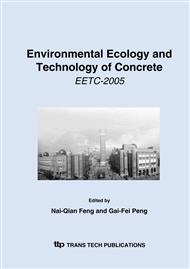[1]
L. Tang, L. Nilsson: Rapid determination of the chloride diffusivity in concrete by applying an electrical field, ACI Mater, Vol. 89 (1992), pp.49-53.
Google Scholar
[2]
C. Andrade: Calculation of chloride diffusion coefficients in concrete from ionic migration measurements, Cement and Concrete Research, Vol. 23(1993), pp.724-742.
DOI: 10.1016/0008-8846(93)90023-3
Google Scholar
[3]
McGrath., P. and Hooton, R.D.: Influence of Voltage on Chloride Diffusion Coefficients From Chloride Migration Tests, Cement and Concrete Research, Vol. 26(1996), pp.1239-1244.
DOI: 10.1016/0008-8846(96)00094-4
Google Scholar
[4]
W.J. McCarter, G. Starrs, T.M. Chrisp: Electrical conductivity, diffusion, and permeability of Portland cement-based mortar, Cement and Concrete Research,Vol. 30 (2000), pp.1395-1400.
DOI: 10.1016/s0008-8846(00)00281-7
Google Scholar
[5]
P. Claisse: Transport Properties of Concrete, Concrete international, January (2005), pp.43-48.
Google Scholar
[6]
Powers, T. C.: Structure and Physical Properties of Hardened Portland Cement Pastes, Journal of American Ceramic Society, Vol. 41 (1958), pp.1-6.
Google Scholar
[7]
Kosmatika, S. H., Kerkhoff, B. and Panarese, W. C.: Design and Control of Concrete Mixtures. 14 th Edition, Portland Cement Association, Skokie, IL, (2002).
Google Scholar
[8]
Mindess, S. and Young, J. F.: Concrete (Englewood Cliffs, NJ: Prentice-Hall International Inc, 1981).
Google Scholar
[9]
Hansen, T. C.: Physical structure of hardened cement pastes - a classic approach, Materials and Structure, Vol. 19 (1986), pp.423-436.
Google Scholar
[10]
Powers, T. C., L. E. Copeland, J. C. Hayes, and H. M. Mann.: Permeability of portland cement paste, ACl Journal Proceedings, 51 (1954), pp.285-98.
Google Scholar
[11]
Popovics, S.: Strength and Related Properties of Concrete - A Quantitative Approach (New York: John Wiley and Sons, Inc. 1998).
Google Scholar
[12]
Shi, C. and Xie, P.: Interface between Cement Paste and Quartz Sand in Alkali-Activated Slag Mortars, Cement and Concrete Research, Vol28 (1998), pp.887-896.
DOI: 10.1016/s0008-8846(98)00050-7
Google Scholar
[13]
US Bureau of Reclamation: Concrete Manual, 8 th Edition, Denver, Colorado, 1975 Nordtest Method: Accelerated Chloride Penetration into Hardened Concrete(Nordtest, Espoo, Finland, Proj. 1154-94, 1995).
Google Scholar
[14]
Volkwein, A.: Convection of Chloride Ions into Concrete Due to Hydration Suction and Capillary Suction, Proceedings of the 6th International Conference on Durability of Building Materials and Components, Omlya, Japan, ed by Nagataki, S., , Nireki, T. and Tomosawa, F., London: E&F Spon, (1993).
Google Scholar
[15]
Jensen, O. M.: Thermodynamic limitation of self-desiccation, Cement and Concrete Research Vol. 25(1995), pp.157-164.
DOI: 10.1016/0008-8846(94)00123-g
Google Scholar
[16]
Kumar, A. and Roy, D. M.: The effect of desiccation on the porosity and pore structure of freeze dried hardened portland cement and slag-blended pastes, Cement and Concrete Research, Vol. 16 (1986), pp.74-78.
DOI: 10.1016/0008-8846(86)90070-0
Google Scholar
[17]
NT BUILD 355, Chloride Diffusion Coefficient From Migration Cell Experiments, Nordtest, Tekniikantie 12, FIN-02150 Espoo, FINLAND, (1997).
Google Scholar
[18]
NT BUILD 492, Chloride Migration Coefficient From Non-Steady-State Migration Experiments, Nordtest, Tekniikantie 12, FIN-02150 Espoo, FINLAND, (1999).
Google Scholar
[19]
Elsener, B., Molina, M. and Bohni, H.: The electrochemical removal of Chlorides from Reinforced Concrete, Corrosion Science Vol. 35 (1993), pp.1563-1570.
DOI: 10.1016/0010-938x(93)90385-t
Google Scholar


